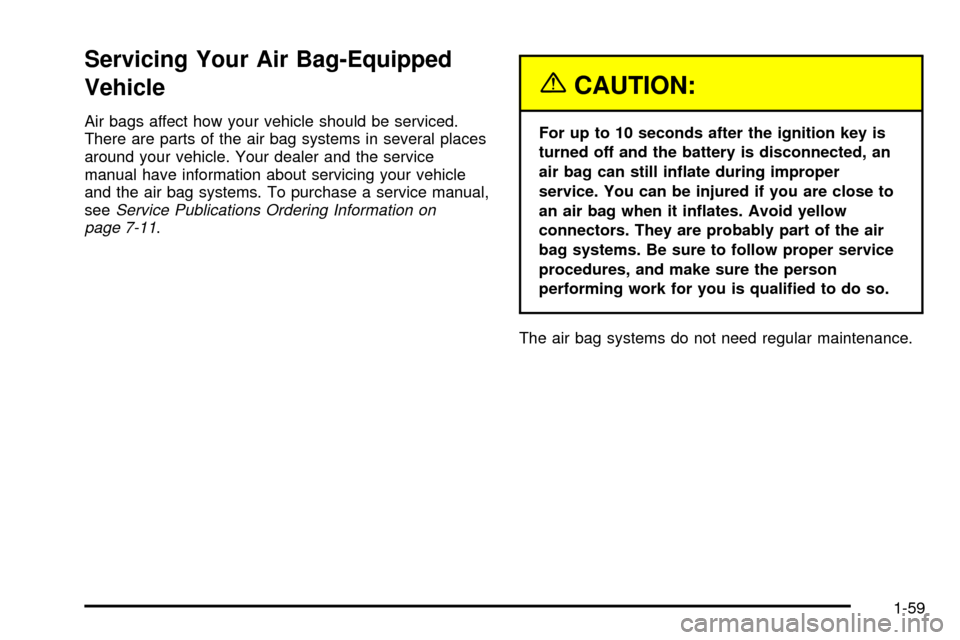CADILLAC DEVILLE 2003 8.G Repair Manual
Manufacturer: CADILLAC, Model Year: 2003, Model line: DEVILLE, Model: CADILLAC DEVILLE 2003 8.GPages: 423, PDF Size: 2.91 MB
Page 61 of 423

{CAUTION:
If something is between an occupant and an
air bag, the bag might not in¯ate properly or it
might force the object into that person causing
severe injury or even death. The path of an
in¯ating air bag must be kept clear. Don't put
anything between an occupant and an air bag,
and don't attach or put anything on the
steering wheel hub or on or near any other air
bag covering. Don't let seat covers block the
in¯ation path of a side impact air bag.
When Should an Air Bag In¯ate?
The driver's and right front passenger's frontal air bags
are designed to in¯ate in moderate to severe frontal or
near-frontal crashes. But they are designed to in¯ate only
if the impact speed is above the system's designed
ªthreshold level.º
In addition, your vehicle has ªdual stageº frontal air bags,
which adjust the amount of restraint according to crash
severity. For moderate frontal impacts, these air bags
in¯ate at a level less than full deployment. For more
severe frontal impacts, full deployment occurs.If the front of your vehicle goes straight into a wall that
doesn't move or deform, the threshold level for the
reduced deployment is about 10 to 16 mph (18 to
26 km/h), and the threshold level for a full deployment is
about 18 to 24 mph (29 to 38.5 km/h). The threshold level
can vary, however, with speci®c vehicle design, so that it
can be somewhat above or below this range.
If your vehicle strikes something that will move or deform,
such as a parked car, the threshold level will be higher.
The driver's and right front passenger's frontal air bags
are not designed to in¯ate in rollovers, rear impacts, or in
many side impacts because in¯ation would not help the
occupant.
The side impact air bags are designed to in¯ate in
moderate to severe side crashes. A side impact air bag
will in¯ate if the crash severity is above the system's
designed ªthreshold level.º The threshold level can vary
with speci®c vehicle design. Side impact air bags are not
designed to in¯ate in frontal or near-frontal impacts,
rollovers or rear impacts, because in¯ation would not help
the occupant. A side impact air bag will only deploy on
the side of the vehicle that is struck.
In any particular crash, no one can say whether an air
bag should have in¯ated simply because of the damage
to a vehicle or because of what the repair costs were. For
frontal air bags, in¯ation is determined by the angle of the
impact and how quickly the vehicle slows down in frontal
and near-frontal impacts. For side impact air bags,
in¯ation is determined by the location and severity of the
impact.
1-55
Page 62 of 423

What Makes an Air Bag In¯ate?
In an impact of sufficient severity, the air bag sensing
system detects that the vehicle is in a crash. For
both the frontal and side impact air bags, the sensing
system triggers a release of gas from the in¯ator, which
in¯ates the air bag. The in¯ator, air bag and related
hardware are all part of the air bag modules inside the
steering wheel, instrument panel and the side of the
front seatbacks and behind the rear seatbacks closest to
the door.
How Does an Air Bag Restrain?
In moderate to severe frontal or near frontal collisions,
even belted occupants can contact the steering wheel or
the instrument panel. In moderate to severe side
collisions, even belted occupants can contact the inside
of the vehicle. The air bag supplements the protection
provided by safety belts. Air bags distribute the force of
the impact more evenly over the occupant's upper
body, stopping the occupant more gradually. But the
frontal air bags would not help you in many types
of collisions, including rollovers, rear impacts, and many
side impacts, primarily because an occupant's motion
is not toward the air bag.
Side impact air bags would not help you in many types of
collisions, including frontal or near frontal collisions,
rollovers, and rear impacts, primarily because an
occupant's motion is not toward those air bags. Air bags
should never be regarded as anything more than a
supplement to safety belts, and then only in moderate to
severe frontal or near-frontal collisions for the driver's and
right front passenger's frontal air bags, and only in
moderate to severe side collisions for the side impact
air bags.
1-56
Page 63 of 423

What Will You See After an Air Bag
In¯ates?
After the air bag in¯ates, it quickly de¯ates, so quickly
that some people may not even realize the air bag
in¯ated. Some components of the air bag module ± the
steering wheel hub for the driver's air bag, the
instrument panel for the right front passenger's bag, the
side of the seatback closest to the door for the side
impact air bags ± will be hot for a short time. The parts
of the bag that come into contact with you may be
warm, but not too hot to touch. There will be some
smoke and dust coming from the vents in the de¯ated
air bags. Air bag in¯ation doesn't prevent the driver from
seeing or being able to steer the vehicle, nor does it
stop people from leaving the vehicle.
{CAUTION:
When an air bag in¯ates, there is dust in the
air. This dust could cause breathing problems
for people with a history of asthma or other
breathing trouble. To avoid this, everyone in
the vehicle should get out as soon as it is safe
to do so. If you have breathing problems but
can't get out of the vehicle after an air bag
in¯ates, then get fresh air by opening a
window or a door. If you experience breathing
problems following an air bag deployment, you
should seek medical attention.
1-57
Page 64 of 423

Your vehicle has a feature that will automatically unlock
the doors and turn the interior lamps on when the air
bags in¯ate (if battery power is available). You can lock
the doors again and turn the interior lamps off by
using the door lock and interior lamp controls.
In many crashes severe enough to in¯ate an air bag,
windshields are broken by vehicle deformation.
Additional windshield breakage may also occur from the
right front passenger air bag.
·Air bags are designed to in¯ate only once. After an
air bag in¯ates, you'll need some new parts for
your air bag system. If you don't get them, the air
bag system won't be there to help protect you
in another crash. A new system will include air bag
modules and possibly other parts. The service
manual for your vehicle covers the need to replace
other parts.
·Your vehicle is equipped with an electronic frontal
sensor, which helps the sensing system distinguish
between a moderate frontal impact and a more
severe frontal impact. Your vehicle is also equipped
with a crash sensing and diagnostic module,
which records information about the frontal air bag
system. The module system records information
about the readiness of the system, when the system
commands air bag in¯ation and driver's safetybelt usage at deployment or near-deployment
crash. The module also records speed, engine rpm,
brake and throttle data.
·Let only quali®ed technicians work on your air bag
systems. Improper service can mean that an air
bag system won't work properly. See your dealer for
service.
Notice:If you damage the covering for the driver's
or the right front passenger's air bag, or the air
bag covering on the driver's, right front passenger's
or rear seatback, the bag may not work properly.
You may have to replace the air bag module in the
steering wheel, both the air bag module and the
instrument panel for the right front passenger's air
bag, or both the air bag module and seatback
for the side impact air bag. Do not open or break
the air bag coverings.
1-58
Page 65 of 423

Servicing Your Air Bag-Equipped
Vehicle
Air bags affect how your vehicle should be serviced.
There are parts of the air bag systems in several places
around your vehicle. Your dealer and the service
manual have information about servicing your vehicle
and the air bag systems. To purchase a service manual,
see
Service Publications Ordering Information on
page 7-11.
{CAUTION:
For up to 10 seconds after the ignition key is
turned off and the battery is disconnected, an
air bag can still in¯ate during improper
service. You can be injured if you are close to
an air bag when it in¯ates. Avoid yellow
connectors. They are probably part of the air
bag systems. Be sure to follow proper service
procedures, and make sure the person
performing work for you is quali®ed to do so.
The air bag systems do not need regular maintenance.
1-59
Page 66 of 423

Restraint System Check
Checking Your Restraint Systems
Now and then, make sure the safety belt reminder light
and all your belts, buckles, latch plates, retractors
and anchorages are working properly. Look for any other
loose or damaged safety belt system parts. If you see
anything that might keep a safety belt system from doing
its job, have it repaired.
Torn or frayed safety belts may not protect you in a
crash. They can rip apart under impact forces. If a belt
is torn or frayed, get a new one right away.
Also look for any opened or broken air bag covers, and
have them repaired or replaced. (The air bag system
does not need regular maintenance.)
Replacing Restraint System Parts
After a Crash
{CAUTION:
A crash can damage the restraint systems in
your vehicle. A damaged restraint system may
not properly protect the person using it,
resulting in serious injury or even death in a
crash. To help make sure your restraint
systems are working properly after a crash,
have them inspected and any necessary
replacements made as soon as possible.
If you've had a crash, do you need new belts or LATCH
system parts?
After a very minor collision, nothing may be necessary.
But if the belts were stretched, as they would be if worn
during a more severe crash, then you need new parts.
1-60
Page 67 of 423

If the LATCH system was being used during a more
severe crash, you may need new LATCH system parts.
If belts are cut or damaged, replace them. Collision
damage also may mean you will need to have LATCH
system, safety belt or seat parts repaired or replaced.
New parts and repairs may be necessary even if the belt
or LATCH system wasn't being used at the time of
the collision.If an air bag in¯ates, you'll need to replace air bag
system parts. See the part on the air bag system earlier
in this section.
If the frontal air bags in¯ate, you'll also need to replace
the driver's and right front passenger's safety belt
buckle assembly. Be sure to do so. Then the new buckle
assembly will be there to help protect you in a collision.
1-61
Page 68 of 423

-NOTES
1-62
Page 69 of 423

Keys...............................................................2-3
Remote Keyless Entry System.........................2-4
Remote Keyless Entry System Operation...........2-5
Doors and Locks.............................................2-8
Door Locks....................................................2-8
Central Door Unlocking System........................2-9
Power Door Locks..........................................2-9
Programmable Automatic Door Locks................2-9
Rear Door Security Locks..............................2-10
Lockout Protection........................................2-11
Leaving Your Vehicle....................................2-11
Trunk..........................................................2-11
Windows........................................................2-15
Power Windows............................................2-16
Sun Visors...................................................2-18
Theft-Deterrent Systems..................................2-19
PASS-Key
žIII ..............................................2-21
PASS-KeyžIII Operation...............................2-21
Starting and Operating Your Vehicle................2-23
New Vehicle Break-In....................................2-23
Ignition Positions..........................................2-23
Starting Your Engine.....................................2-25Engine Coolant Heater..................................2-25
Automatic Transaxle Operation.......................2-27
Parking Brake..............................................2-32
Shifting Into Park (P).....................................2-34
Shifting Out of Park (P).................................2-37
Parking Over Things That Burn.......................2-38
Engine Exhaust............................................2-38
Running Your Engine While You Are Parked. . . .2-39
Mirrors...........................................................2-40
Automatic Dimming Rearview Mirror with
OnStar
ž...................................................2-40
Automatic Dimming Rearview Mirror with
OnStar
žand Compass...............................2-40
Outside Power Mirrors...................................2-42
Outside Automatic Dimming Mirror..................2-43
Outside Curb View Assist Mirror.....................2-43
Outside Convex Mirror...................................2-44
Outside Heated Mirrors..................................2-44
OnStar
žSystem.............................................2-45
HomeLinkžTransmitter...................................2-47
Programming the HomeLinkžTransmitter.........2-48
Section 2 Features and Controls
2-1
Page 70 of 423

Storage Areas................................................2-51
Glove Box...................................................2-51
Instrument Panel Storage Area.......................2-51
Cellular Telephone........................................2-51
Front Storage Area.......................................2-51
Full Floor Console Storage Area.....................2-51
Center Console Storage Area.........................2-51
Center Flex Storage Unit...............................2-52
Map Pocket.................................................2-52
Assist Handles.............................................2-53Garment Hooks............................................2-53
Umbrella Holder...........................................2-53
Floor Mats...................................................2-53
Rear Storage Area........................................2-53
Rear Storage Door Trim Armrest.....................2-53
Convenience Net..........................................2-53
Sunroof.........................................................2-54
Vehicle Personalization...................................2-55
Memory Seat, Mirrors and Steering Wheel.......2-55
Section 2 Features and Controls
2-2